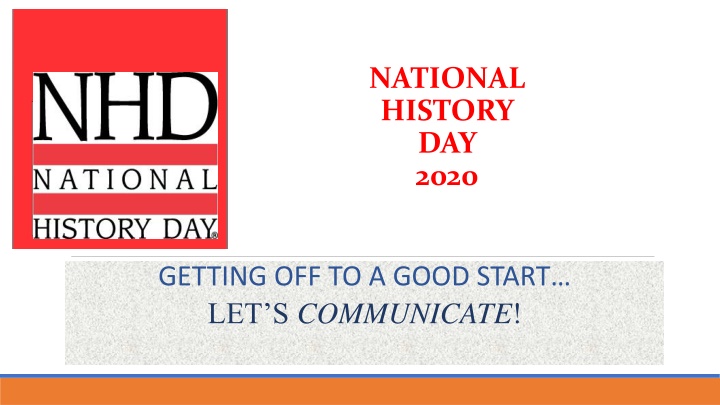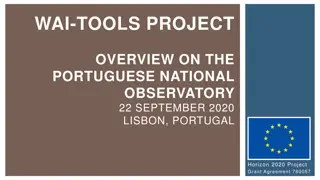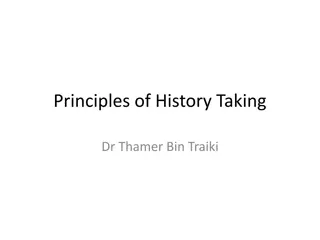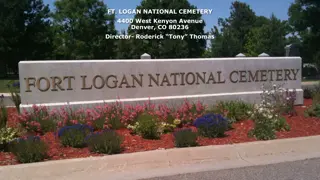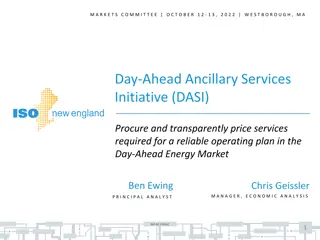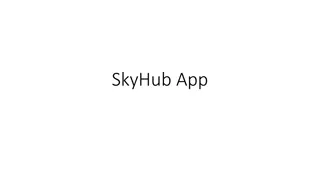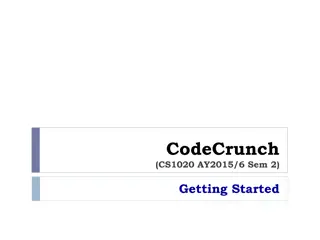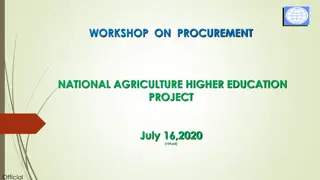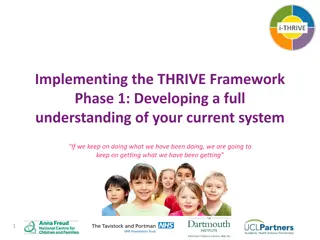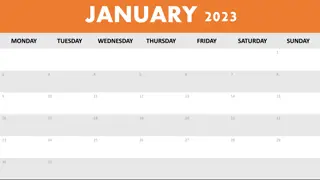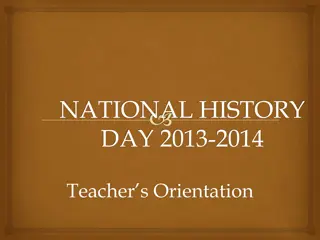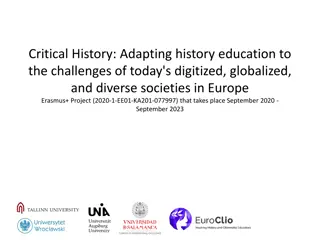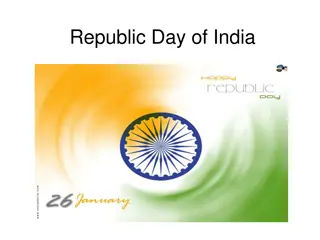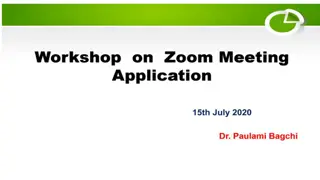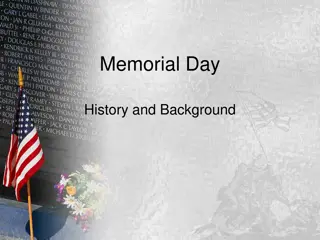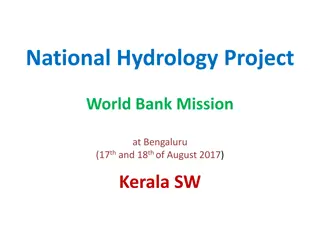National History Day 2020 - Getting Started on Your Project
Explore the categories, process, and topic selection for National History Day 2020. Learn how to pick a compelling topic that has historical significance and fits within the contest guidelines. Understand the life cycle of a project from research to feedback. Consider your talents and resources to decide whether to work individually or in a group. Start your journey towards creating a meaningful entry for the contest!
Download Presentation

Please find below an Image/Link to download the presentation.
The content on the website is provided AS IS for your information and personal use only. It may not be sold, licensed, or shared on other websites without obtaining consent from the author.If you encounter any issues during the download, it is possible that the publisher has removed the file from their server.
You are allowed to download the files provided on this website for personal or commercial use, subject to the condition that they are used lawfully. All files are the property of their respective owners.
The content on the website is provided AS IS for your information and personal use only. It may not be sold, licensed, or shared on other websites without obtaining consent from the author.
E N D
Presentation Transcript
NATIONAL HISTORY DAY 2020 GETTING OFF TO A GOOD START LET S COMMUNICATE!
How the Contest Works Five categories: Paper (Individual only) Website Performance Documentary Exhibit Individuals or groups of 2-5 Junior (grades 6-8) or Senior (grades 9-12) division 2
IT HELPS TO KNOW THE CATEGORIES SO YOU CAN CONSIDER YOUR TALENTS! ARTISTS LOVE TO DO EXHIBIT BOARDS TECH SAVVY KIDS LOVE DOING WEBSITES ARTISTS WITH TECH SKILLS LOVE DOING DOCUMENTARIES PERFORMERS LOVE DOING PERFORMANCES (DUH!!!) WRITERS LOVE TO WRITE HISTORICAL PAPERS (DOUBLE DUH!!) DON T GET DON T GET TOO FAR TOO FAR AHEAD OF AHEAD OF YOURSELF! YOURSELF! YOU CAN CONSIDER THE TIME YOU HAVE TO SPEND YOU CAN CONSIDER THE RESOURCES YOU HAVE YOU CAN CAREFULLY CONSIDER IF YOU WANT TO WORK IN A GROUP OR INDIVIDUALLY
A Students Process Topic Research Thesis Analysis Synthesis Entry creation Contest Feedback Project Life Cycle: September-June
PICK A TOPIC.(LIKE HOW???) PICK A TOPIC .(LIKE HOW???) FIRST AND FOREMOST REMEMBER THIS IS NATIONAL HISTORY DAY! You literally can do any topic YOU want It does not have to BE history BUT It MUST HAVE history This means, you must be able to analyze the subject of your NHD project over time, AT LEAST 30 years. Why?Because an NHD project must consider the SO WHAT. So how did this person/these events/this subject impact society/people/the world in its own time and over time. SO WHAT makes this significant to research and to share? (Example: How cool is TikTok?! But it has not been around very long certainly not long enough to see its impact on users in their lifetime. That would be a generation 30 years minimum.)
How do I pick a topiccontinued: How do I pick a topic continued: WHAT INTERESTS DO YOU HAVE? WHAT FASCINATES YOU? WHAT QUESTIONS WOULD YOU LIKE TO EXPLORE? The world is open to you! ANY TIME PERIOD (except the recent, but everything started somewhere so go back to the beginnings! (Like: what was around before TikTok?) ANY SUBJECT BROADWAY! ICE HOCKEY! NASA! REVOLUTIONARY WAR!
NARROW DOWN THAT TOPIC! NARROW DOWN THAT TOPIC! CONNECT TO THE THEME!!!! NHD HAS A THEME EACH YEAR WHY? Because researchers work from a thesis. Finding and developing a thesis is HARD!! Historians have challenges with developing a thesis statement. SOOOOO! NHD provides a THEME! This theme gives YOU the researcher a way to find that SO WHAT the significance of your topic.
2021 THEME (drum roll.) COMMUNICATION IN HISTORY: THE KEY TO UNDERSTANDING
What comes to mind What comes to mind Communication is how people exchange information and interact with each other. Consider: Methods? Models? How communication has changed over time How communication was key in a major moment AND
THE OBVIOUS (which can be really interesting!) THE OBVIOUS (which can be really interesting!) INNOVATIONS LIKE TELEGRAPH TELEPHONE TELEVISION WHAT ABOUT RADIO?? WHAT ABOUT FILM? SILENT MOVIES TALKIES WHAT ABOUT THE PRINTING PRESS?!!
WHAT ABOUT WHAT ABOUT CONVENTIONS? Like Seneca Falls The first presidential convention PROTEST MOVEMENTS? Alice Paul (a NJ woman!) and the Suffragettes? MLK March on Washington RIOTS? against apartheid in South Africa against the Viet Nam War in the U.S
WHAT ABOUT WHAT ABOUT FORMS OF COMMUNICATION AMERICAN SIGN LANGUAGE BRAILLE ESPIONAGE (Navaho Code Talkers Enigma Code) NEWSPAPERS (Yellow Journalism) LETTERS (John and Abigail Adams Zola and the Dreyfus Affair) BOOKS (That little lady who started the big war ) MUSIC ( South Pacific. 60s Rock. Hip Hop) ART Portraits (conveying a message ) Political cartoons ( You furnish the pictures. I ll furnish the war. ) Photography (Ansel Adams) Architectural design (Frank Lloyd Wright)
WHAT ABOUT WHAT ABOUT MIS-COMMUNICATION IN NEGOTIATIONS (Native American treaties) IN WAR (Remember the Maine!) IN ORGANIZATIONS (95 Theses) IN INDUSTRY (Post-it notes Life Saver candy)
WHAT ABOUT OUR NJ HISTORY? WHAT ABOUT OUR NJ HISTORY? Not only are local topics interesting, you can find amazing primary sources!! Here are some ideas New Jersey had no newspapers of its own in the colonial period. News and advertisements came from New York and Philadelphia papers. How does this compare to the present? The first newspapers in New Jersey were established during the American Revolution to convey news and opinions about the war. Why was this important? The creation of political parties in the 1790s led to the creation of more newspapers, and they then were affiliated with specific parties. How did newspapers communicate ideas about politics?
In the mid nineteenth century, women speaking in public was frowned on. How did suffrage pioneers like Sarah and Angelina Grimke, Lucy Stone, and Elizabeth Cady Stanton, all of whom resided in New Jersey for a period of time, challenge these restrictions? In the early nineteenth century, New Jersey was a pioneer in the development of railroads and canals. How did this development improve communication about current events? During the United States Civil War, Washington Roebling, a trained engineer from Trenton, was a pioneer in using hot-air balloons for reconnaissance. How did hot-air balloon contribute to the Union s war effort?
During World War I, the War Services Bureau at Rutgers helped connect students and alumni serving overseas with faculty and administration back at Rutgers. What was the impact of this network? During the Second World War, soldiers mail was heavily censored. How did New Jersey soldiers manage to communicate with their loved ones back home? In the early twentieth century, Guglielmo Marconi experimented with a wireless telegraph in Franklin Township and Wall Township, New Jersey. How did Marconi s invention contribute to the Allied victory during World War II? Among his many inventions, Thomas Alva Edison made significant improvements to the telegraph and telephone at his New Jersey laboratory. What was the impact of these improvements in communication?
Selman A. Waksman, a Rutgers University professor of microbiology, is best known for the discovery of streptomycin, which earned him the Nobel Prize in 1952. In later years, it became apparent that graduate student Albert Schatz and others were also involved in the discovery. How did the norms of scientific communication prevent them from being recognized? A union official who helped found the National Negro Labor Council, Ernest Thompson (1907 1971) was also a community activist who helped bring about political and economic gains for African Americans in New Jersey. What tools did community organizers use to bring attention to their causes before the advent of digital communication? For more on how to research NJ topics, see the PowerPoint from Prof. Perrone of Rutgers University.
BEFORE YOU GET STARTED BEFORE YOU GET STARTED YOU ARE DOING AN NHD PROJECT SO TAKE A MOMENT TO CONSIDER What is a PROCESS PAPER? What is an ANNOTATED BIBLIOGRAPHY? WHAT ARE THE RULES!!!
Contest Rules What? Rules for all entries Specific rules for each category Why? Apples to apples KNOW THE RULES BEFORE YOU BEGIN!! 19
AND IT IS A CONTEST AND IT IS A CONTEST SO CONSIDER HOW YOUR PROJECT WILL BE JUDGED
Evaluating Entries: Historical Quality: 60% Accuracy Thorough research Primary sources Balanced presentation Thoughtful analysis and interpretation Relation to Theme: 20% Relation is adequately explained Historical context Historical significance Clarity of Presentation: 20% Effective and creative Clear and free of errors/distractions Use of equipment
DO YOU SEE???? DO YOU SEE???? 60% IS RESEARCH SECONDARY SOURCES FIRST GET THE BASICS WHO, WHAT, WHEN, WHERE PRIMARY SOURCES ADD DEPTH HELPS GET TO THE HOW AND WHY AS A RESEARCHER, YOU HAVE TO ASK GOOD QUESTIONS AND FIND THE ANSWERS YOU HAVE TO LOOK AT ALL SIDES OF AN ISSUE YOU HAVE TO BE AWARE OF AND BE WARY OF BIAS IN THE SOURCES AND IN YOU HAVE TO INTERPRET AND ANALYZE IN LIGHT OF THE THEME AND YOUR AND YOU HAVE TO DRAW CONCLUSIONS (SO WHAT!!!) YOURSELF! THESIS
DO YOU SEE???? DO YOU SEE???? 20% IS CONNECTION TO THE THEME MAKE THAT CONNECTION IN YOUR THESIS MAKE THAT CONNECTION IN YOUR TITLE! (The title and thesis statement MAKE THAT CONNECTION IN YOUR CONCLUSION (The SO WHAT!) are closely linked) Go deep. If your thesis is just a statement of fact or obvious, you have missed interpreting and analyzing. Thinking takes time. Start the research process asap!
A Students Process A Student s Process Timeline and TIPS Timeline and TIPS Topic Research CONNECT TO THE THEME!) ASAP and ONGOING Keep an updated bibliography *** NOVEMBER WORKING THESIS. Final thesis and title by January. Once you register (February 1st) that title is set! Analysis NOVEMBER onward Thinking takes time! Synthesis JANUARY onward Deep thinking takes more time! Entry creation JANUARY until contest Enjoy the creative process! Contest MARCH for Regionals. Websites and papers due end of February ASAP Remember what interests YOU! Thesis
***AN IMPORTANT NOTE ON CITATIONS ***AN IMPORTANT NOTE ON CITATIONS DATES MATTER!! NOT THE DATE YOU FOUND IT ON THE WEB BUT THE DATE THE PAPER, BOOK, DOCUMENT, PHOTO, ADVERTISTMENT, ETC. WAS ACTUALLY PUBLISHED. NOODLETOOLS (or other bibliographic aides) IS AN EXCELLENT TOOL BUT The citations are created from what YOU input. If you do not note the date, or page, or title of the article, etc. etc., it will NOT appear in your citation. AND THAT IS TRAGIC!!!
Your Mission Discover a love of history Develop research skills Become a critical thinker Uncover our inner talents Enjoy the intellectual and creative process!
